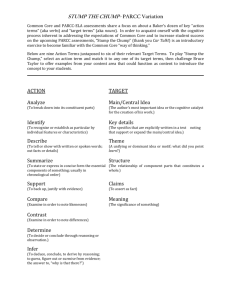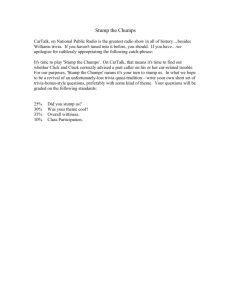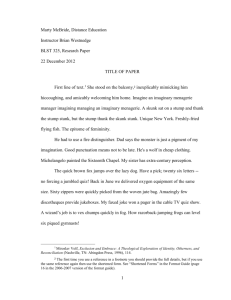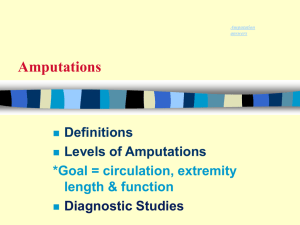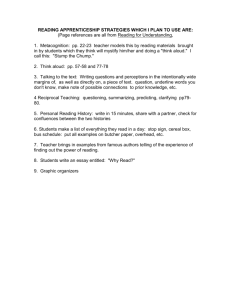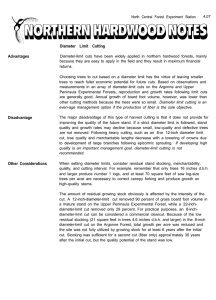II 11111!11&-IIDJIII t�Sim� NIB'JIDIB
advertisement
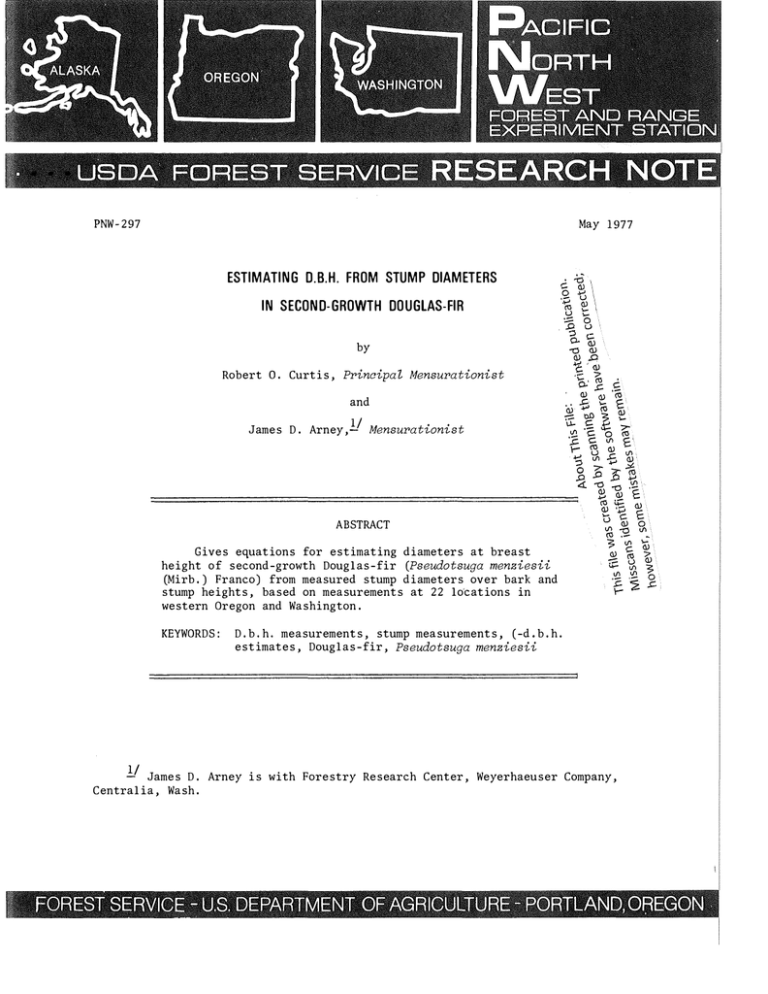
' . · · · 11Dmri1BI II m IIBirll t�Sim� IGIBI 11111 !11&-IIDJIII ' May 1977 PNW-297 ESTIMATING D.B.H. FROM STUMP DIAMETERS IN SECOND-GROWTH DO UGLAS-FIR by Robert 0. Curtis, Principal Mensurationist and James D. Arney, !! Mensurationist ABSTRACT Gives equations for estimating diameters at breast height of second-growth Douglas-fir (Mirb.) Franco) stump heights, (Pseudotsuga menziesii from measured stump diameters over bark and based on measurements at 22 lo'cations in western Oregon and Washington. KEYWORDS: D.b.h. measurements, stump measurements, (-d.b.h. estimates, Douglas-fir, Pseudotsuga menziesii !! NIB'JIDIB James D. Arney is with Forestry Research Center, Weyerhaeuser Company, Centralia, Wash. INTRODUCTION In a yield study of coastal Douglas-fir (Pseudotsuga menziesii (Mirb.) Franco), we found that some of our thinned plot records lacked a tally of trees cut in the initial thinning. In some cases there was a record of stump diameters of cut trees or such information could be obtained by field measurements. To reconstruct initial stand conditions, we needed appropriate regressions relating diameter at breast height (d. b.h.) to diameter and height of stump. Similar needs to estimate tree d.b.h. from stump measurements occur in other research and management activities. Several people have developed estimating equations for specific stands or local areas; but we found no such equations (l) which were based on a sample distributed over a wide geographic area and a range of site conditions, (2) which applied to a wide range of diameters within second-growth stands, and (3) which explicitly included stump height as a variable. Therefore, we have developed such equations from field measurements made by the Pacific Northwest Forest and Range Experiment Station's Olympia Laboratory and by Weyerhaeuser Company's Forestry Research Center. THE DATA Measurements were obtained from 22 field installations in western Washington and Oregon. Total number of trees measured was 454, with a range in d.b.h. from 2 to 42 inches. Maximum age was about 80 years; however, most trees were much smaller and younger than the maximum size and age. Field procedure on each individual plot, within each installation, was: 1. Select a number (usually four) of normally formed Douglas-fir, across the range of diameters present. 2. Measure and record to nearest 0.1 inch: a. b. c. d. e. d.b. h. outside bark. d.o.b. (diameter outside bark) at 2.0 feet above ground level. d.o.b. at 1.0 foot above ground level. d.o.b. at 0.5 foot above ground level. d. o.b. at 0.25 foot above ground level (measurement omitted where root swell made measurement impracticable). All measurements were made with diameter tape. ANALYSIS 1. Individual installations Regressions of the form D.b.h. = a + b(d.o.b.) + 2 c(d.o.b.) were fitted to the data from each installation, separately for each height of measurement, H 2.0, 1.0, 0.5, and 0.25 ft. Usually, the squared term was nonsignificant. When present, curvilinearity was slight. = 2 Regressions were plotted and superimposed. Inspection indicated that (a) lines for a given stump height were parallel or nearly so, and (b) al­ though there might be small differences in elevation, possibly related to stand conditions, any such differences were too small to have much effect on practical applications. 2. Individual heights of measurement All measurements for a given height were combined and a regression D.b.h. a + b(d.o.b.) + c(d.o.b.) 2 was fitted separately for each stump height. In each regression, the squared term was statistically significant but curvature was slight and apparently due mainly to a few of the largest trees. 3. All data combined Scatter diagrams, calculated standard errors of estimate, and plots of residuals indicated that variance increased with diameter outside bark and with distance of the measurement point from breast height. A weighted stepwise conditioned regression was fitted to all measure­ ments combined, of the form: w[d.b.h. - d.o.b.] wa (4.5-H) 1 + 2 wa (4.5-H) 2 4 + w[d.o.b.][b (4.5-H) + ... + b (4.5-H) ] 4 1 4 2 + c (4.5-H) ] + w[d.o.b.] [c (4.5-H) + 4 1 4 3 + w[d.o.b.] [d (4.5-H) + + d (4.5-H) ] 4 1 !< in which w 1/[(4.5-H)(d.o.b.) 2], a weighting factor which provided approximate uniformity of variance; and a, b, c, and d are regression coefficients. = The resulting equation can be written as: D. b.h. = a + b(d.o.b.) + c(d.o.b.) 2 3 + d(d.o.b.) ; (1) 3 4 - 0.00217612(H) ; where a = d 0.027392(H); 2 0.64885 + 0.27258(H) - 0.113191(H) b c 0.12327 = + 0.025339(H) 2 0.0025583 - 0.0011370(H) + 0.00012634(H) ; and -0.000066158 + 0.000014702(H). D.b.h. is diameter outside bark, in inches, at breast height. D.o.b. is diameter outside bark, in inches, at point of stump measurement. 3 H is height above ground, in feet, Standard error of estimate SEE in inches d.b.h. = 0.0402 at point of measurement. (SEE) of this equation was 0.0402; (4.5-H) (d.o.b.) i.e., 2, Curves corresponding to equation 1 are shown in figure 1. For individual height measurements, equation 1 reduces to: H = 2.0 feet: D.b.h. H = = = + 0.90914 (d.o.b.) + 0.00078965 (d.o.b.) + 0.8314l (d.o.b.) + 0.0015476 (d.o.b.) + 0.75987 (d.o.b.) + 0.0020214 (d.o.b.) + 0.7103l (d.o.b.) + 0.0022819 (d.o.b.) 2 - 0.000036755 (d.o.b.) = 0.09587 = 0.10957 = 0.11642 2 3 - 0.000051456 (d.o.b.) . (3) 2 3 - 0.000058807 (d.o.b.) . (4) 2 3 - 0.000062483 (d.o.b.) . (5) Curves corresponding to the above equations are shown in figures 2-5, together with superimposed data points (a few points over 40 inches omitted) . Relationships are virtually straight lines for trees under 24 inches; curvature is slight and is due to the few trees of larger size. 36 H=2.0 ft 32 H=1.0 ft 28 H=0.25 ft H=0.5 ft w :c (.) 2 :c 24 20 16 co 0 12 8 4 4 8 12 16 20 24 28 32 36 40 STUMP DIAMETER O.B. (INCHES) Figure 1--curves of d.b.h. over stump d.o.b. and stump height 4 (2) 0.25 foot: D.b.h. en 3 . 0.5 foot: D.b.h. H 0.06848 1.0 foot: D.b.h. H = (equation 1). 36 32 28 (f) w :I: u z :I: 24 20 16 en Q 12 8 4 4 8 12 16 20 24 32 28 36 40 STUMP DIAMETER O.B. (INCHES) Figure 2--Data points and curve of d.b.h. over stump d.o.b. at 2.0 feet above ground (equation 2). 36 32 28 (f) w :I: u z :I: 24 20 16 en Q 12 8 4 4 8 12 16 20 24 28 32 36 40 STUMP DIAMETER O.B. (INCHES) Figure 3--Data points and curve of d.b.h. over stump d.o.b. at 1.0 foot above ground (equation 3). 5 36 32 28 (/) w :r: u z 24 :r: 16 2.0 cc 0 ., ·.·:: 12 8 4 /'' -L 0 0 LL-L 4 -L 8 L. J i I-LJi iL i-L l 12 16 IJi-LJi-LIJi-L i-LI 20 24 28 32 -L -L i 36 l 40 STUMP DIAMETER O.B. (INCHES) Figure 4--Data points and curve of d. b.h. 0. 5 foot above ground over stump d.o.b. at (equation 4). 36 32 28 (/) w :r: u z :r: 24 20 16 cc 0 12 8 4 4 8 12 16 20 24 28 32 36 40 STUMP DIAMETER O.B. (INCHES) Figure 5--Data points and curve of d. b. h. over stump d.o. b. 0.25 foot above ground 6 (equation 5). at If stumps over 24 inches in diameter are excluded, the following simple linear regressions give nearly identical estimates: Stum.e height D.b.h. = Sturn.e height D.b.h. = D. b.h. = Sturn.e height D.b.h. = = 0.9162 (d.o.b.) (6) + (7) 0.8374 (d.o.b.) 0.5 foot: 0.10 = + 1.0 foot: 0.11 = Stump height 2.0 feet: 0.04 = + 0.7793 (d.o.b.) (8) 0.25 foot: 0.7369 (d.o.b.) (9) Approximating the above by d.b.h./d.o.b. ratios leads to a nearly equivalent equation for stump diameters measured at variable heights: 1063 ) (d.o.b.) D.b.h. 0.8522 (H' = (10) APPLICATION The relationships given are based on measurements made with diameter tape, over bark. Therefore, in applications, stump diameter measurements must be made over bark. If bark is partially or wholly missing, an appropriate ocular adjust­ ment must be made at the time of measurement or bark thickness factors must be supplied. If stumps are tallied by diameter over bark and height of stump, d.b.h. can be estimated by equation 1. In many situations, however, the range in size of stumps present in any one plot or stand is quite limited. It may be more con­ venient to measure or estimate stump diameters over bark at one of the standard heights used here (2.0, 1. 0, 0.5, 0.25 ft) and then to use equations 2-5 or figure 1 to estimate the corresponding d.b.h. If stumps do not exceed 24 inches in diameter, equations 6-9 will give nearly identical estimates and are more convenient. And, if measurements are to a variable stump height, equation 10 is only slightly less precise and is simple enough for ready use with a pocket calculator. METRIC EQUIVALENTS 1.0 inch 0.25 ft 0.50 ft 1.0 ft 2.0 ft breast height 4.5 ft 2.54 7.62 15.24 30.48 60.96 137.2 ern ern em ern em em 7 The mission of the PACIFIC NORTHWEST FOREST AND RANGE EXPERIMENT STATION is to provide the knowledge, technology, and alternatives for present and future protection, management, and use of forest, range, and related environments. Within this overall mission, the Station conducts and stimulates research to facilitate and to accelerate progress toward the following goals: I. Providing safe and efficient technology for inventory, protection, and use of resources. 2. Developing and evaluating alternative methods and levels of resource management. 3. Achieving optimum sustained resource productivity consistent with maintaining a high quality forest environment. The area of research encompasses Oregon, Washington, Alaska, and, in some cases, California, Hawaii, the Western States, and the Nation. Results of the research are made available promptly. Proj ect headquarters are at: Fairbanks, Alaska Portland, Oregon Juneau, Alaska Olympia, Washington Bend, Oregon Seattle, Washington Corvallis, Oregon Wenatchee, Washington La Grande, Oregon Mailing address: Pacific Northwest Forest and Range Experiment Station P.O. Box 3141 Portland, Oregon 97208 GPO 998•559
